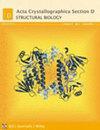Long wavelength Mesh&Collect native SAD phasing on microcrystals
IF 2.2
4区 生物学
Acta Crystallographica Section D: Biological Crystallography
Pub Date : 2019-02-01
DOI:10.2210/PDB6H2M/PDB
引用次数: 0
Abstract
Harnessing the anomalous signal from macromolecular crystals with volumes of less than 10 000 µm3 for native phasing requires careful experimental planning. The type of anomalous scatterers that are naturally present in the sample, such as sulfur, phosphorus and calcium, will dictate the beam energy required and determine the level of radiation sensitivity, while the crystal size will dictate the beam size and the sample-mounting technique, in turn indicating the specifications of a suitable beamline. On the EMBL beamline P13 at PETRA III, Mesh&Collect data collection from concanavalin A microcrystals with linear dimensions of ∼20 µm or less using an accordingly sized microbeam at a wavelength of 1.892 A (6.551 keV, close to the Mn edge at 6.549 keV) increases the expected Bijvoet ratio to 2.1% from an expected 0.7% at 12.6 keV (Se K edge), thus allowing experimental phase determination using the anomalous signal from naturally present Mn2+ and Ca2+ ions. Dozens of crystals were harvested and flash-cryocooled in micro-meshes, rapidly screened for diffraction (less than a minute per loop) and then used for serial Mesh&Collect collection of about 298 partial data sets (10° of crystal rotation per sample). The partial data sets were integrated and scaled. A genetic algorithm for combining partial data sets was used to select those to be merged into a single data set. This final data set showed high completeness, high multiplicity and sufficient anomalous signal to locate the anomalous scatterers, and provided phasing information which allowed complete auto-tracing of the polypeptide chain. To allow the complete experiment to run in less than 2 h, a practically acceptable time frame, the diffractometer and detector had to run together with limited manual intervention. The combination of several cutting-edge components allowed accurate anomalous signal to be measured from small crystals.长波长网格&收集微晶体上的原生SAD相位
利用体积小于10,000 μ m3的大分子晶体的异常信号进行天然相位需要仔细的实验规划。样品中自然存在的异常散射体的类型,如硫、磷和钙,将决定所需的光束能量并决定辐射灵敏度的水平,而晶体大小将决定光束大小和样品安装技术,进而指示合适的光束线的规格。在PETRA III的EMBL波束线P13上,Mesh&Collect使用波长为1.892 A (6.551 keV,接近Mn边缘,为6.549 keV)的相应尺寸的微光束收集线尺寸为~ 20 μ m或更小的concanavalin A微晶体的数据,将预期的Bijvoet比率从12.6 keV (Se K边缘)的预期0.7%增加到2.1%,从而允许使用自然存在的Mn2+和Ca2+离子的异常信号进行实验相位测定。收集数十个晶体并在微网格中快速冷冻,快速筛选衍射(每个循环不到一分钟),然后用于串行Mesh&Collect收集约298个部分数据集(每个样品10°晶体旋转)。对部分数据集进行整合和缩放。采用遗传算法对部分数据集进行组合,选择合并成单个数据集。该最终数据集具有高完整性、高多样性和足够的异常信号来定位异常散射体,并提供相位信息,从而实现多肽链的完全自动跟踪。为了使整个实验在不到2小时内完成,衍射仪和检测器必须在有限的人工干预下一起运行。几个尖端组件的组合允许从小晶体中测量精确的异常信号。
本文章由计算机程序翻译,如有差异,请以英文原文为准。
求助全文
约1分钟内获得全文
求助全文
来源期刊
自引率
13.60%
发文量
0
审稿时长
3 months
期刊介绍:
Acta Crystallographica Section D welcomes the submission of articles covering any aspect of structural biology, with a particular emphasis on the structures of biological macromolecules or the methods used to determine them.
Reports on new structures of biological importance may address the smallest macromolecules to the largest complex molecular machines. These structures may have been determined using any structural biology technique including crystallography, NMR, cryoEM and/or other techniques. The key criterion is that such articles must present significant new insights into biological, chemical or medical sciences. The inclusion of complementary data that support the conclusions drawn from the structural studies (such as binding studies, mass spectrometry, enzyme assays, or analysis of mutants or other modified forms of biological macromolecule) is encouraged.
Methods articles may include new approaches to any aspect of biological structure determination or structure analysis but will only be accepted where they focus on new methods that are demonstrated to be of general applicability and importance to structural biology. Articles describing particularly difficult problems in structural biology are also welcomed, if the analysis would provide useful insights to others facing similar problems.

 求助内容:
求助内容: 应助结果提醒方式:
应助结果提醒方式:


